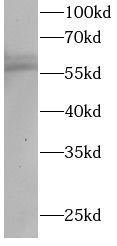Products
RORC antibody
Category:
Research Area:
| Synonyms: | NR1F3 antibody, Nuclear receptor ROR gamma antibody, Nuclear receptor RZR gamma antibody, RAR related orphan receptor C antibody, RORC antibody, RORG antibody, RZR GAMMA antibody, RZRG antibody, TOR antibody | ||
| Catalogue No.: | FNab10046 | Reactivity: | Human |
| Host: | Rabbit | Tested Application: | ELISA, WB |
| Clonality: | polyclonal | Isotype: | IgG |
- SPECIFICATIONS
- Product Name
- RORC antibody
- Catalogue No.
- FNab10046
- Size
- 100μg
- Form
- liquid
- Purification
- Immunogen affinity purified
- Purity
- ≥95% as determined by SDS-PAGE
- Clonality
- polyclonal
- Isotype
- IgG
- Storage
- PBS with 0.02% sodium azide and 50% glycerol pH 7.3, -20℃ for 12 months(Avoid repeated freeze / thaw cycles.)
Immunogen
- Immunogen
- RAR-related orphan receptor C
- Alternative Names
- NR1F3 antibody, Nuclear receptor ROR gamma antibody, Nuclear receptor RZR gamma antibody, RAR related orphan receptor C antibody, RORC antibody, RORG antibody, RZR GAMMA antibody, RZRG antibody, TOR antibody
- UniProt ID
- P51449
- Observed MW
- 58 kDa
Application
- Tested Applications
- ELISA, WB
- Recommended dilution
- WB: 1:500 - 1:2000
Validated Images
 HT29 cells were subjected to SDS PAGE followed by western blot with FNab10046(RORC antibody) at dilution of 1:1000
HT29 cells were subjected to SDS PAGE followed by western blot with FNab10046(RORC antibody) at dilution of 1:1000
- Background
- Nuclear receptor that binds DNA as a monomer to ROR response elements(RORE) containing a single core motif half-site 5'-AGGTCA-3' preceded by a short A-T-rich sequence. Key regulator of cellular differentiation, immunity, peripheral circadian rhythm as well as lipid, steroid, xenobiotics and glucose metabolism(PubMed:19381306, PubMed:19965867, PubMed:22789990, PubMed:26160376, PubMed:20203100). Considered to have intrinsic transcriptional activity, have some natural ligands like oxysterols that act as agonists(25-hydroxycholesterol) or inverse agonists(7-oxygenated sterols), enhancing or repressing the transcriptional activity, respectively(PubMed:19965867, PubMed:22789990). Recruits distinct combinations of cofactors to target gene regulatory regions to modulate their transcriptional expression, depending on the tissue, time and promoter contexts. Regulates the circadian expression of clock genes such as CRY1, ARNTL/BMAL1 and NR1D1 in peripheral tissues and in a tissue-selective manner. Competes with NR1D1 for binding to their shared DNA response element on some clock genes such as ARNTL/BMAL1, CRY1 and NR1D1 itself, resulting in NR1D1-mediated repression or RORC-mediated activation of the expression, leading to the circadian pattern of clock genes expression. Therefore influences the period length and stability of the clock. Involved in the regulation of the rhythmic expression of genes involved in glucose and lipid metabolism, including PLIN2 and AVPR1A(PubMed:19965867). Negative regulator of adipocyte differentiation through the regulation of early phase genes expression, such as MMP3. Controls adipogenesis as well as adipocyte size and modulates insulin sensitivity in obesity. In liver, has specific and redundant functions with RORA as positive or negative modulator of expression of genes encoding phase I and Phase II proteins involved in the metabolism of lipids, steroids and xenobiotics, such as SULT1E1. Also plays also a role in the regulation of hepatocyte glucose metabolism through the regulation of G6PC and PCK1(PubMed:19965867). Regulates the rhythmic expression of PROX1 and promotes its nuclear localization(PubMed:19381306, PubMed:19965867, PubMed:22789990, PubMed:26160376, PubMed:20203100). Plays an indispensable role in the induction of IFN-gamma dependent anti-mycobacterial systemic immunity(PubMed:26160376). Isoform 2: Essential for thymopoiesis and the development of several secondary lymphoid tissues, including lymph nodes and Peyer's patches. Required for the generation of LTi(lymphoid tissue inducer) cells. Regulates thymocyte survival through DNA-binding on ROREs of target gene promoter regions and recruitment of coactivaros via the AF-2. Also plays a key role, downstream of IL6 and TGFB and synergistically with RORA, for lineage specification of uncommitted CD4(+) T-helper(T(H)) cells into T(H)17 cells, antagonizing the T(H)1 program. Probably regulates IL17 and IL17F expression on T(H) by binding to the essential enhancer conserved non-coding sequence 2(CNS2) in the IL17-IL17F locus. May also play a role in the pre-TCR activation cascade leading to the maturation of alpha/beta T-cells and may participate in the regulation of DNA accessibility in the TCR-J(alpha) locus.



